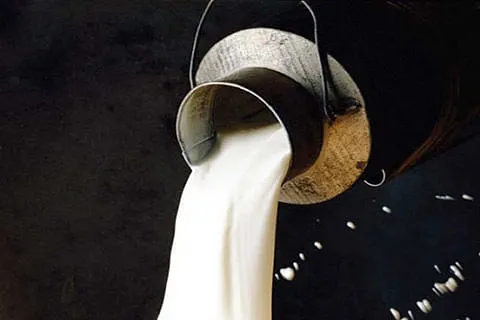Milk is highly nutritious having abundance of carbohydrates, proteins, fats, minerals and vitamins.
At the same time milk is an ideal medium for growth of spoilage and pathogenic bacteria predisposing it to deterioration and as such it has a meagre shelf life at room temperature.
The perishable nature of milk is the most important challenge that dairy farmers have to face. Surplus milk in bulk quantity has to be disposed of quickly.
Apart from hygienic handling, temperature control is the most important factor that is to be kept in mind vis-à-vis milk preservation as bacteria grow and multiply within an optimum range of temperature.
Milk is to be obtained from cows in a hygienic manner either manually or through Milking Machines.
It is to be quickly cooled below 4 degrees C so that bacteria aren’t allowed to multiply to prevent spoilage or it has to be quickly boiled so that most bacteria are killed.
The best way to tackle surplus fluid milk is to process it and convert it into milk-products. Dairy farmers have the option to convert fluid milk into Curd, Cheese, Butter, Ghee, Ice-cream, Khoa etc.
Moreover, by virtue of UHT (Ultra High Temperature) treatment, the shelf life of milk can be extended to 6 months when it is packed in Tetra Packs.
The said milk is sterilised and doesn’t need any preservatives or refrigeration until the pack is opened. Or the milk can be dried and converted into powdered form for increased shelf-life.
Value addition of fluid milk by processing and conversion to milk-based products enhances shelf life of milk and gives better returns to farmers.
Dairy farmers can avail benefits of various schemes such as Integrated Dairy Development Scheme (IDDS) and procure Dairy Machinery such as Curd/Cheese/Butter/Ghee/Ice-cream making machines.
Even Bulk Milk Coolers (BMCs) for cooling/storing milk, Vans for transportation and Milking Machines/Milking Parlours too are available for the eligible farmers.
Dr. Zubair Ahmad War has done Masters in Livestock Production and Management (LPM)
Disclaimer: The views and opinions expressed in this article are the personal opinions of the author.
The facts, analysis, assumptions and perspective appearing in the article do not reflect the views of GK.






